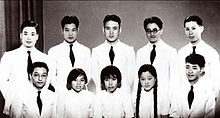Qian Sanqiang


Qian Sanqiang (simplified Chinese: 钱三强; traditional Chinese: 錢三強; October 16, 1913 – June 28, 1992), also known as Tsien San-Tsiang, was a Chinese nuclear physicist and among the leading scientists of the Two Bombs, One Satellite program. Due to his central role in the development of China's nuclear industry and nuclear weapons program, he is referred to as the "father of China's atomic bomb".[1][2] Coincidentally, China's first atomic bomb test was conducted on Qian's 51st birthday.
Biography
[edit]
A native of Huzhou, Zhejiang Province, China, Qian was born in Shaoxing, the son of the scholar Qian Xuantong. Qian attended Peking University and Tsinghua University, graduating in 1936 in the same class as his future wife He Zehui. Qian went to France in 1937. He studied in the Collège de Sorbonne and Collège de France, doing research under Frédéric Joliot-Curie and Irène Joliot-Curie. He obtained the French doctorate in 1940.[1]
Qian returned to China in 1948 with his wife, the nuclear physicist He Zehui,[2] where he took up a professorship at the Tsinghua University and in 1950 founded the Institute of Modern Physics of the Chinese Academy of Sciences (CAS), today known as the China Institute of Atomic Energy.[1]
In 1954 he joined the Chinese Communist Party. He served successively as Director of the Institute of Modern Physics under the Chinese Academy of Sciences, Vice-Minister of the Second Ministry of Machine Building, Vice-President of the Chinese Academy of Sciences[3] and honorary Chairman of the China Association for Science and Technology.
Qian made outstanding contributions to the establishment of nuclear science in the People's Republic of China and to the development of the PRC's atomic and hydrogen bombs under the Two Bombs, One Satellite program. In 1999, he and 22 other Chinese scientists and technologists who had made significant contributions to the program were awarded the Two Bombs, One Satellite Meritorious Service Award Medal (Chinese: 两弹一星功勋奖章). [2]
During the Cultural Revolution, Qian was deported to the countryside for "socialist re-education," due to suspicion aroused by his participation in the Nationalist government's delegation to a UNESCO conference in 1946.[4]
After the end of the Cultural Revolution, Qian was appointed to become a member of the Chinese Academy of Sciences. He was also permitted to resume his work in the atomic energy industry.[5]
References
[edit]- ^ a b c "那年今日丨中国的"原子弹之父"钱三强诞生_科技湃_澎湃新闻-The Paper". www.thepaper.cn. Archived from the original on 2022-10-30. Retrieved 2017-10-16.
- ^ a b c Kristof, Nicholas D. (3 July 1992). "Qian Sanqiang, Chinese Physicist On Atom Bomb Team, Dies at 79". New York Times. Archived from the original on 8 November 2018. Retrieved 10 February 2015.
- ^ "钱三强----中国科学院学部". casad.cas.cn. Archived from the original on 2022-10-30. Retrieved 2022-07-28.
- ^ Cao, Cong (2012). Mr. Science and Chairman Mao's Cultural Revolution : Science and Technology in Modern China. Darryl E. Brock, Cong Cao, Yinghong Cheng, Susan Greenhalgh, Dongping Han, Michael A. Mikita. Lanham: Lexington Books. p. 124. ISBN 978-0-7391-4975-1. OCLC 853360078. Archived from the original on 2022-11-24. Retrieved 2023-03-08.
- ^ "Qian Sanqiang - China Nuclear Forces". www.globalsecurity.org. Archived from the original on 2022-10-30. Retrieved 2022-03-31.
